Media | Articles
1991–96 Ford Escort: Relive the ’90s in a Rad-Era Bargain
It was the Memorex mixtapes that got me. After he bought his 1994 Ford Escort LX, Michael Shelangoski made nine tapes of his favorite ‘80s and ‘90s jams to play in it. Seeing them there in 2022, for an instant, made me feel like it was 1998 again. In the spring of ’98, my friend Sarah and I, both art majors at Ohio’s Oberlin College, went on a back road blast to the Cleveland Museum of Art in her ‘94 Escort GT. A mixtape in the deck played Duran Duran, OMD, and the Stray Cats the whole way.
Songs, like cars, can put you back in a specific moment from the past. I still think of Sarah and that car when I hear “Rio” or “Rock This Town.” (We both regularly DJ’d parties in college.) Michael has similar memories: “Senior year high school, my car was a ‘92 Mercury Tracer LTS, which had the twin-cam Mazda motor like the Escort GT. My friends and I spent lots of time cruising around in that Tracer playing Alanis Morissette’s ‘Jagged Little Pill.’”
Cheap and cheerful, Escorts were perfect for cars for new drivers, budgeters, and college kids alike. Introduced in the spring of 1990, the second-gen 1991–96 U.S. Escort didn’t sell quite as well as its 1981–90 predecessor, but it was a nicer car in many ways. Sharing its chassis with the BG-Series Mazda Protegé, it looked and felt far more modern, and it was both more durable and more fun to drive.
Alas, nobody saves “economy cars.” Most were worked hard, put away wet, and discarded by the time of 2008’s Great Recession.
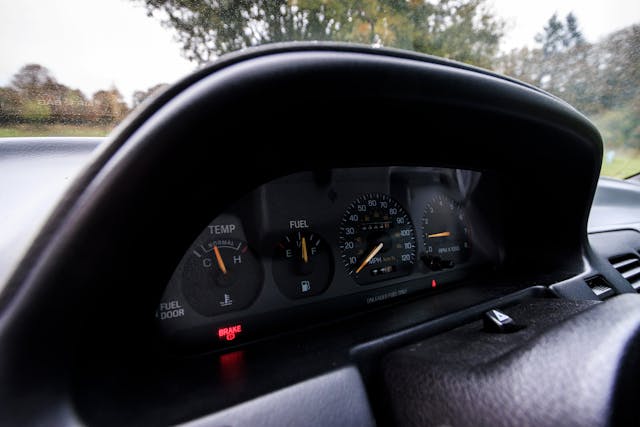
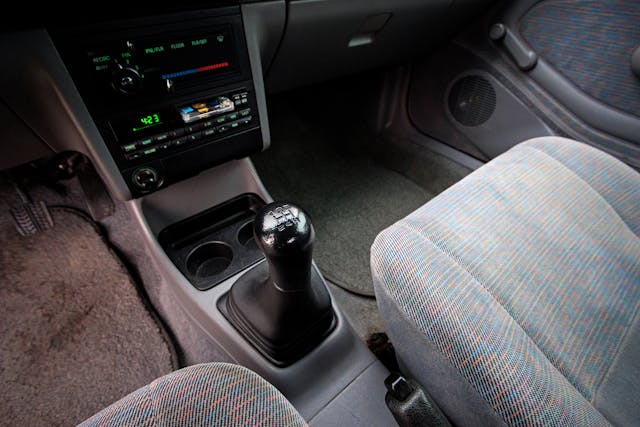

Despite their relative rarity, even the hotter Escort GT is still not all that valuable. Inspired by the music, cars, and clothes of the Radwood era, Shelangoski bought his magenta-hued LX for just $3000. Anything with more than three doors goes for even less, and even near-mint GTs rarely sell for more than $7000. If you can find a nice one, they’re a supreme bargain for a fun and relatively reliable vehicle that blends Eighties and Nineties aesthetics as adeptly as the Trapper Keeper, with an equally vivid color palette.
Marketplace
Buy and sell classics with confidence
To find out how the looks emerged, I tracked down one of the Escort’s original designers, Mark Conforzi. Now retired, Toronto-born Conforzi designed Fords for four decades. In 1986, the Escort was his first U.S. project as an exterior lead after a long stint in Germany. Speaking with Hagerty, Conforzi shared his recollections from the era and, for the first time, confirmed the existence of a wild Easter egg on this now three-decade-old design.
And, as it turns out, he’s also got good taste in contemporary music.
Sierras and Escorts
Conforzi graduated from ArtCenter College of Design in 1978 and, freshly married, immediately traveled overseas with his portfolio in hand. “I think I toured 13 studios in all, from Pininfarina to Ford, and I got a lot of job offers, but I chose Ford of Europe in Cologne. There I got to work on amazing projects like the Sierra and the [European] Escort, and also learned lots of things from very talented people like Ed Golden, Patrick le Quément, Ray Everts, and Trevor Creed.”
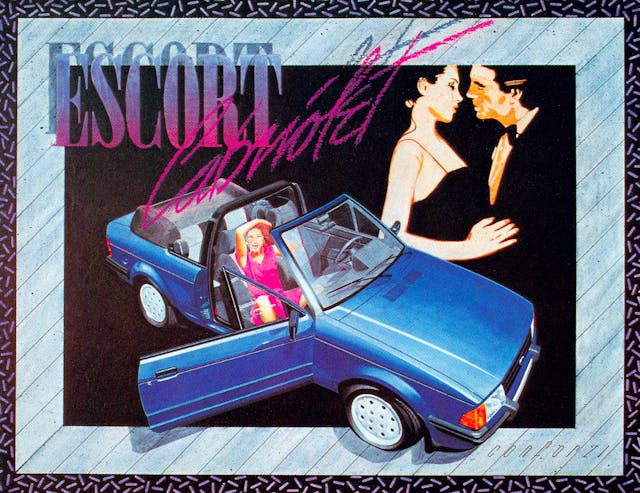
Conforzi’s early time at Cologne was defined by the radically aerodynamic Sierra, but most of his design work was on the European Escort Cabriolet (“I was kind of on my own on that one,” he adds), the circa-1985 Scorpio and 1986’s Mk4 Escort family. “In 1985, [Ford’s U.S. design chief] Jack Telnack asked if I’d like to work in the U.S.” It took a while to sort out the immigration issues, but by 1986 Conforzi was working under Telnack in Dearborn on what would become the 1991 Escort.
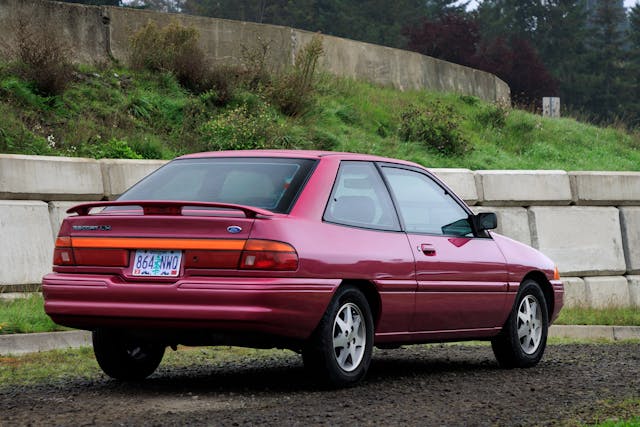
In some ways, there’s a direct line from the Sierra and the 1986 Taurus to the ‘91 Escort.
“It was a time of change, and with cars like the Sierra we were getting into softer shapes,” Conforzi said. While British and European response to the Sierra had initially been mixed, the lozenge-shaped Taurus, partly designed by Ray Everts, was a huge hit with Americans. The U.S.-market 1980s Escort was a big seller, but visually conservative and often criticized as less sophisticated, cosmetically and dynamically, than its European cousins.
“Management was very open to change at that time, which was refreshing,” Conforzi said, so he created much softer, more aerodynamic shapes based on the older hard-edged Escort silhouettes. Nearly flush glass made them look even smoother.
Ford reserved the most extreme treatments for the hot-hatch GT model. “We had a huge wheel program for this car with lots of different designs, and on the colors and materials side of things we were proposing all bold colors. There were also many different spoilers. We even tried a bi-plane design similar to the Sierra XR4i. For the scale of the car, management thought that was a little too much!”

During our conversation, Conforzi dug out an old photo dated January 8, 1987. In it, a bright yellow GT model is seen on Saab-like three-spoke rims. Neither the color—which Conforzi said execs loved at the presentation—nor the wheels made it to showrooms, but otherwise, it’s not far off what got built. (Except for the grille.)
A Totally Tubular Easter Egg
When I first saw Conforzi’s name on a drawing provided by the Ford Heritage Vault, I remembered some sketches he provided for a 1984 story in Car Styling Quarterly about blending illustrations, renderings, and text. Each has a stylized signature with the eight letters of his last name offset at a 50-degree angle. The asymmetrical Escort GT grille has eight inlets at the same angle, so I asked: “Is that an Easter egg? How’d that happen?”
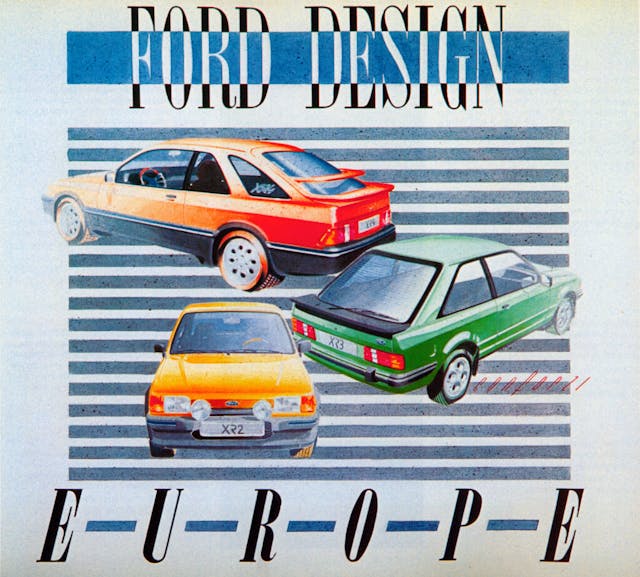
“I had to laugh at this,” Conforzi replied, “But yes, that’s my signature. When I was in Europe, they wanted a signature from all the designers, kind of like it was your character. I came up with this elongated, tubular look for the eight letters inspired by the graphic artist Patrick Nagel. You know him, right?”
(Nagel’s artwork famously graced the album and single covers of Duran Duran’s “Rio” and “Hungry Like the Wolf” in 1982. Yes, I knew him.)
“Translating it to the grille was an unconventional idea, but management was open to it. It has a lot of character, and in its day you could recognize it right away when the car was driving down the road.”

The Nagel connection led to another question. In Conforzi’s photo of the yellow GT presentation, there are mood boards filled with fashion photos and a trio of standees of models wearing very Bananarama-like outfits courtesy of cigarette-adjacent “Virginia Slimwear.” Similarly, his 1984 sketches from Car Styling resemble album art. Every artist looks at the world around them, but how much of a role did fashion, music, and pop culture play in his designs?
“I’ve always been influenced by pop culture, by music, album art, and graphic design, so I definitely borrowed or got influenced by lots of that stuff back then. Being in Europe [in the late 1970s and early 1980s] I also got exposed to lots of bands, Lene Lovich, OMD, I could go on forever.”
The Laser And The Escort
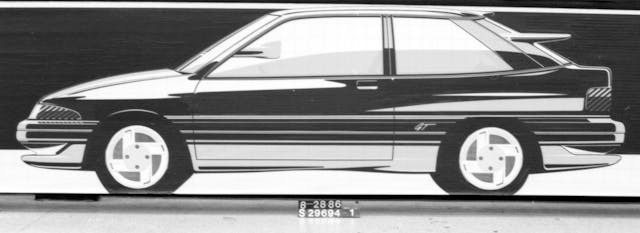
Mechanically, the 1991 Escort, internally coded as project “CT20,” was a major change in engineering philosophy.
The original U.S. model had theoretically been a world car tied to the European Mk3, but its design had widely diverged thanks to the many changes made for U.S. customers. For 1991 there were again new Escorts on both sides of the Atlantic, but the U.S. model followed the recipe of the Asia/Australia Ford Laser and the original Mercury Tracer by using Mazda’s 323/Familia/Protegé platform. The looks, however, came from Dearborn.
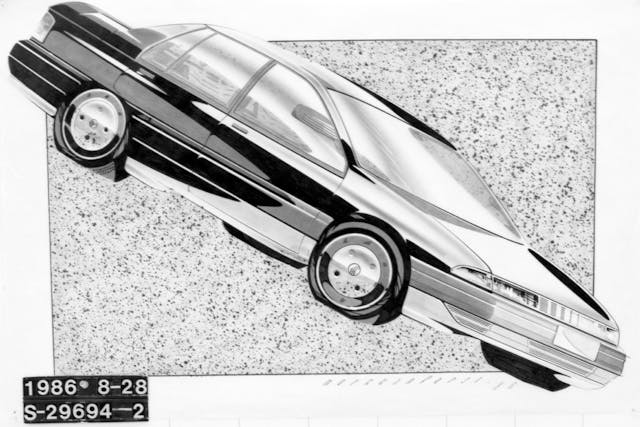
“The international teams did their interpretation of our design. I can’t remember doing any of that work in our studio, and usually with global programs like that the changes you make are for feasibility or manufacturing, not different looks.” Conforzi said.
Lightly modified, the Laser was sold in Australia and Japan into 1994, and in Indonesia and New Zealand until 1996. The real beneficiaries of all this sharing, however, were American drivers.
Mazda, then 25 percent owned by Ford, knew how to make even slow cars fun to drive. All Escorts, indeed, were sharp handlers. There were two engine options. Ford’s 88-horsepower 1.9-liter CVH four—now with sequential port fuel injection—was standard while GTs, starting in the late summer of 1991, came with Mazda’s 127-horse 1.8-liter BP Twin cam. That 1.8 was the same engine found under the hood of the NA Miata. Buyers could choose from a four-speed automatic or a slick-shifting five-speed manual—the latter being the more engaging option.
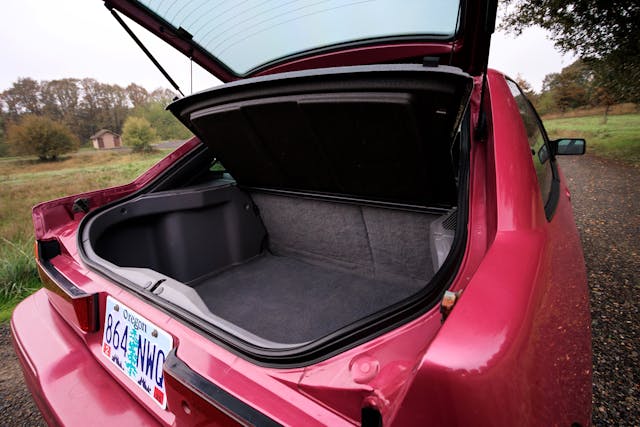
Like the earlier Escort, the 1991 models came as hatchbacks (three- or five-door) and a small wagon. The wagon looked a bit like a scaled-down Taurus wagon, particularly from the rear. A sedan option (shared with the Tracer and designed for both cars) arrived for 1992. The three-doors and wagons were vastly more popular than the sedans and five-doors, and the rarest of all these Escorts is the one-year-only 1992 LX-E—a sedan with the GT engine.
Although the yellow paint never made it to the showroom, plenty of other bold colors did, starting the Cayman Green-colored special edition called the Cayman GT. (All apologies to Porsche, surely.) The GT even offered color-keyed directional wheels for several years, plus other bright colors like Ultra Violet, Bimini Blue, Calypso Green, and Iris Metallic—the color on Shelangoski’s LX. If buyers selected the “LX Sport” option, they got an LX dressed much like a GT and in the same colors, but with the Taurus-style grille instead of the “Conforzi” one.



All told, more than 1.7 million examples were sold before the Escort was redesigned into a rounder but less distinctive wrapper for 1997. It continued to use the old Mazda BG-Series platform.
In the meantime, Conforzi went on to design many more Fords. His work included a role on the retro-themed 2002 Thunderbird project, a car people still frequently ask him about. He’s still an Escort superfan, however, having owned two European Escort Cabriolets and an early-’90s U.S. Escort GT.
A Bargain Rad Ride
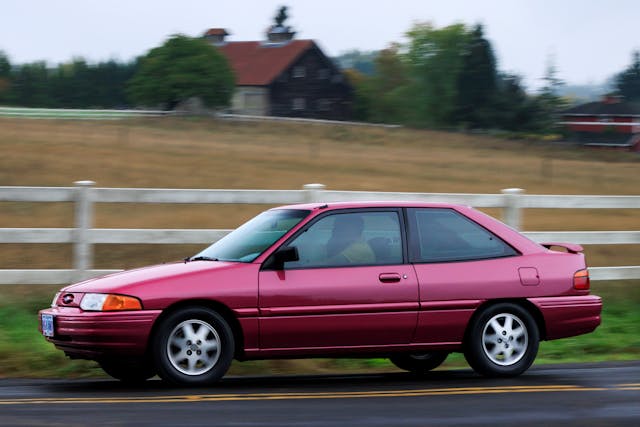
Shelangoski’s Escort experiences, like mine, are from a disconcertingly distant era. In addition to his Tracer, he has owned two other Escort LXs, a ‘91 and a ‘92, during and shortly after college. After not really thinking about them for the better part of two decades, it was music, memories, and friends that led him to buy the vivid LX as his first classic car.
“I went to a Radwood show with a friend in his Chevy Beretta in 2021,” he said. “I immediately felt like ‘these are my people, this is where I belong. I want one of these cars.’” Months later he started looking for an Escort. “My main requirements were that it be a GT, have a manual transmission, and be in a funky color.”
In the end, he settled for two out of three.

Shelangoski bought the car from a family who’d briefly used it to teach their kids to drive; they figured that learning how to drive stick car would give the young ones more options for potential cars. “The dad had picked it up from its original owner in central Washington, who gave up driving at 83. She’d named it ‘Penelope,’ because of the color and Lady Penelope from The Thunderbirds.”
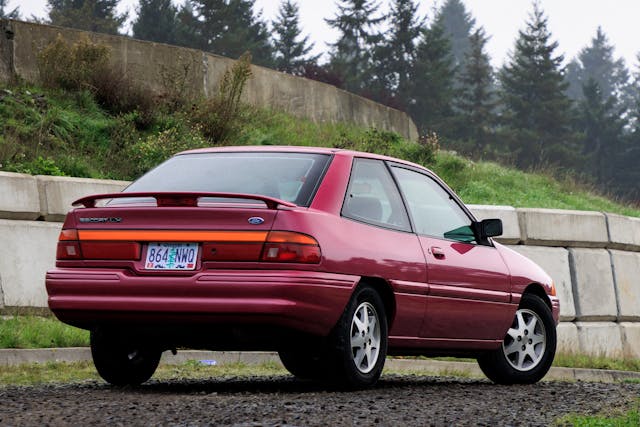
The LX has been easy to live with, even if its CVH engine isn’t the smoothest even by 1990s standards. The original owner maintained the car fastidiously, but after nearly 200,000 miles and two teenagers learning to drive on it, it did need some attention. “Mostly minor things. The dashboard lights and the heater fan weren’t working, and the rearview mirror had fallen off, but nothing that took more than about 48 hours other than replacing the clutch, which was beginning to wear out.”
Like most old cars, there are common items that break: tie rods, wheel bearings, constant control relay modules, wonky thermostats, and valve seats on later CVH-engine cars. However, Escorts and Tracers of this era are hard-wearing, and most mechanical bits aren’t hard to get.
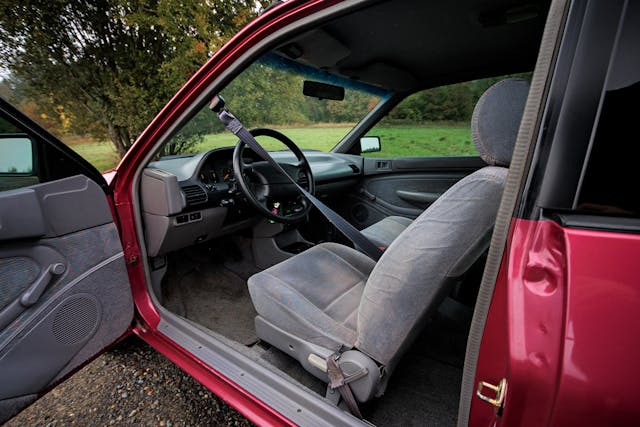
Interior and trim bits, however, are a different story. “As common as these cars once were,” Shelangoski said, “Things like the switches on the motorized seatbelts are extremely difficult to find, so it pays to be part of an owners group or a club.” There is a Ford Escort Owners Association (FEOA) forum, but these days most cars, parts, and advice are found on Facebook.
The cars are cheap to buy, but prices are slowly going up. According to John Wiley, Hagerty’s Manager of Valuation Analytics, from 2013-15 the average quote value range was $2900 to $3200. It’s since risen to between $4000 and $6000. I don’t practice Santería, I ain’t got no crystal ball, but that still sounds like a bargain to me.
***
Check out the Hagerty Media homepage so you don’t miss a single story, or better yet, bookmark it. To get our best stories delivered right to your inbox, subscribe to our newsletters.
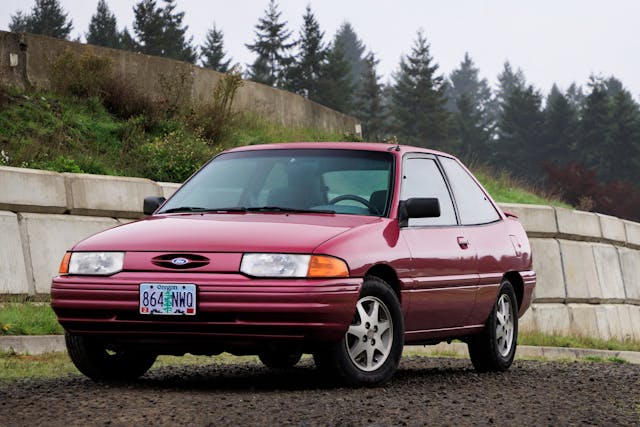




















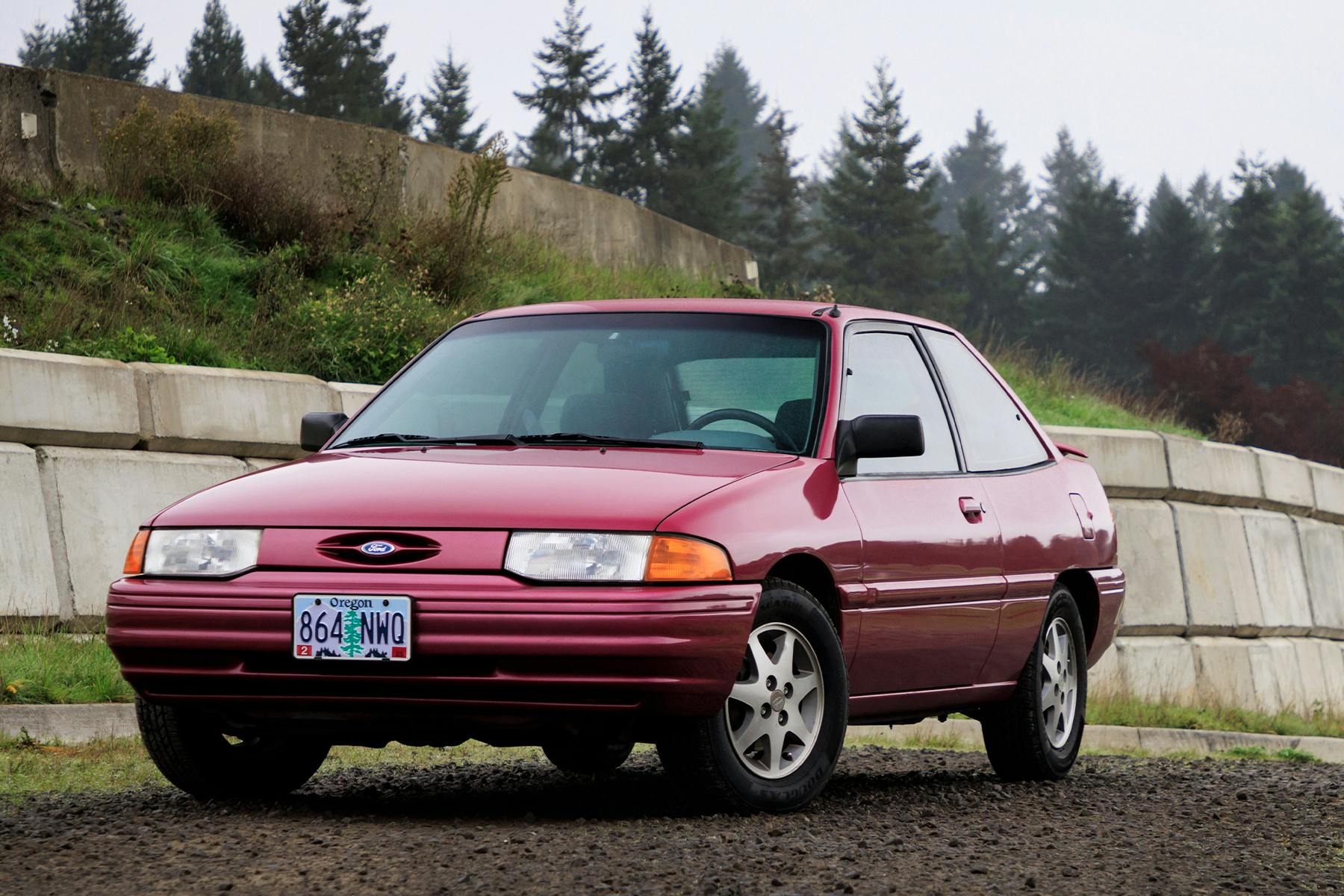
People complain when you write articles about high end cars that most of us can’t afford. Now it goes the other way and now there’s whinners piss and moan about this. These cars are not my thing but there’s room for everything out there, so if you like and enjoy it , go for it.
These were the trusty sidekicks of pizza delivery employees everywhere.
Ironically, I saw one of these coupes today. Not mint, but maybe a #3 to 4. A little old lady (really) was driving it. Among little-old-lady-cars, I would prefer the car of my wife’s late-70’s aunt, about 15 years ago: a VW Jetta with a 5-speed stick – and she knew how to drive it!
One of the best cars Ford ever made was the 2 dr Ford Thunderbird during the 1980s into the early 1990’s.
Had a great small block V8 & a 4 banger turbo coupe that was really a sporty midsize. Great design & really fun to drive!!
Sixty+ years ago my aunts uncles and cousins drove Hillmans none newer than 1952. I bought a dicast one last week. Thankfully no full sized one’s were avalible.